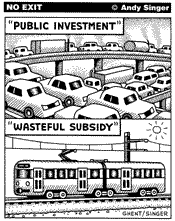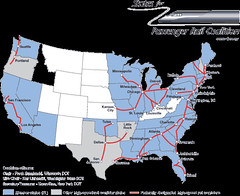The stimulus, planning, and the American Economy

Andy Singer's No Exit comic.
Being a skeptic, I think that we are entering a "correction" of massive proportions where consumer spending could decrease somewhat significantly, reducing the overall size of the economy--people buying fewer cars, fewer clothes, making fewer discretionary purchases, saving more money, etc. will have an impact on the economy in many ways.
If you believe this, today's full page ad in the Washington Post by the American Automobile Association, calling for continued economic support of automobility seems to be asking to continue to "invest" limited federal monies in ways that look backward, rather than forward towards a new paradigm that links transportation and land use planning, and one that focuses on optimal mobility rather than automobility.
There is an article in National Journal about the failure of the finance industry and how it supports Hamiltonian-like industrial policy and heavier government involvement in the economy ("Washington's Sad Triumph"). I am torn about this because while I favor planning, at the same time i think that government, especially federal government tends toward stagnation, because the bureaucratic impulse is for system maintenance, not system improvement, and as special interest groups work to shape federal legislation in their favor.
What we need with government involvement is innovation and transformation. Sometimes we get it--the Internet is one example--but much of the time it is business as usual. (The "Growth Machine" theory about local political and economic elites focused on a joint agenda of local economic growth is easily extended to how industrial and other business sectors work in a similar fashion to shape national policy.)
The "stimulus" proposal gets me down because like most government "stimulus" plans, more than anything, it's a grab bag of programs, elements, and policies du jour. Meanwhile, for the first time in a long time, Americans support spending on infrastructure, and even spending more money in taxes on infrastructure, according to this op-ed, "Rebuilding effort" in yesterday's Baltimore Sun. From the op-ed:
Right now, 78 percent of Americans polled say government is responsible for the failure of America's infrastructure. They don't think the problems can be solved in the first 100 days of a new administration in Washington. Rather, they want ongoing strategic investments to improve America's standard of living and our individual quality of life. When more than 98 percent of Americans believe they have "the right to demand" that America's infrastructure is "efficient, convenient and modern," Washington better not fail.
Despite record transit ridership, virtually every system in the country, except maybe for Rochester, NY (see "Creativity Helps Rochester’s Transit System Turn a Profit" from the New York Times) faces big deficits, service cuts, layoffs, and/or fare increases. See "A mass transit dilemma: Ridership up, funds down" from the Los Angeles Times for a round up on this. (Of course, when the economy is in recession, tax receipts decline, and state and local governments, required to have balanced budgets, must cut services and staff, which is a policy that only deepens a recession.)

So the reason I get skeptical of government planning is because it often promotes stagnation, many government programs don't build value or increase return on investment. And building long term value is what I think government should be about, first and foremost.
So thinking about how Spain is reformulating its national transportation policy around high speed rail, makes me sad that the U.S. doesn't have a national transportation policy built around high speed rail in the corridors where it makes the most sense.
For example, in the Midwest, where Wisconsin State Governor Jim Doyle suggested that
Federal economic stimulus money could be used to build a Midwestern high-speed passenger rail system that would link Chicago to Minneapolis with stops at Milwaukee, Madison and even Green Bay
according to "Gov. Doyle pushes high-speed rail for stimulus funds" from the Milwaukee Journal-Sentinel.
Just as the U.S. built (through economic subsidy or stimulus) a national railroad system in the 1860s, why not begin rebuilding our economy around reduction in oil use by doing the same for the 21st Century. A north-south east coast high speed rail corridor, along with the same along the west coast, and a upper and lower transcontinental high speed rail corridor would be the way to do this. Rebuilding U.S. railroad technology capacity would be a way to employ the hundreds of thousands of unemployed manufacturing workers, and would be a far better use of stimulus money that $80 million for new loading docks for the Philadelphia Museum of Art.

The gaps in this map from the States for Passenger Rail Coalition shows the need for a national policy and plan...
Labels: federal policies and the city, federal spending, national economic competitiveness, provision of public services, railroads, transit, transportation planning



0 Comments:
Post a Comment
<< Home